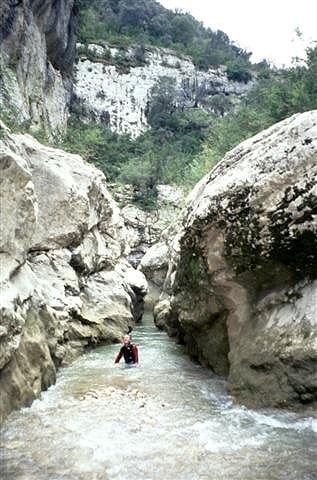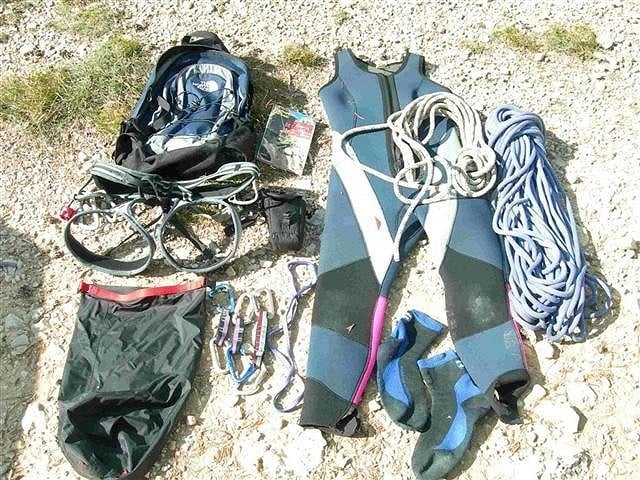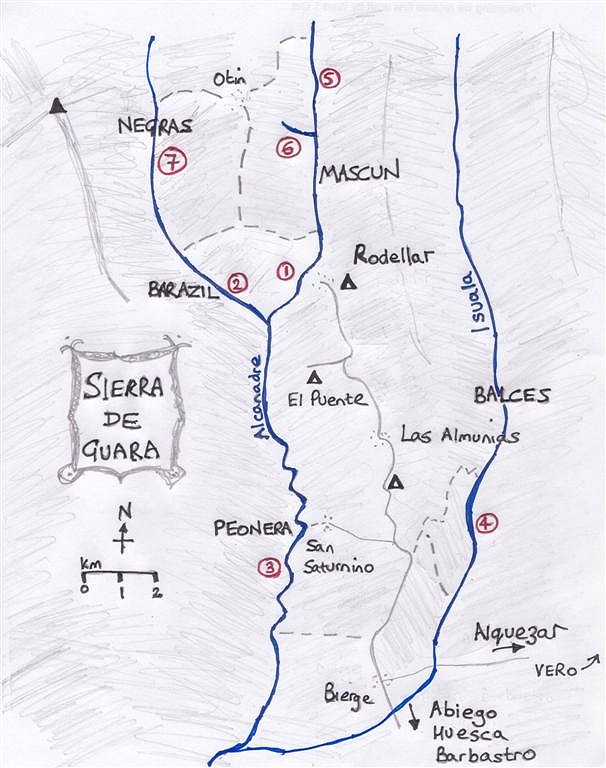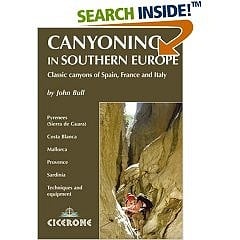

The Basics:
Essentially, canyoning – the descent of natural gorges by a mixture of hiking, scrambling, swimming and rappeling – is a spicy mix of all good things adventurous. Like climbing, you have the walk-in, the anticipation of an unknown route, and the walk-out. Your route takes a defined feature that is often inescapable, and you have the freedom and pleasure of fast movement. You can take a picnic and have a splash about - if you enjoy sea-level traverses, you'll enjoy canyoning. Plus, as on a sea cliff, there is a certain frisson of commitment when you pull the ropes after abbing in: no way back, only one way out.
Any team with a bit of climbing experience can give it a go. With a rope, harness and a few slings and krabs, you're half-way to a complete set of kit, and an advantage of Rodellar is that you can hire wet suits and anything else you might need.
If you've never worn a wetsuit before, you'll be amazed at how buoyant you become. Few things can be more peaceful than floating motionlessly on your back, effortlessly drifting downstream, huge canyon walls above you, distant black shapes of soaring vultures overhead. Strangely, the buoyancy makes it almost impossible to swim properly or quickly, and the most effective stroke seems to be a sort of slow motion doggy-paddle.
The technical aspects of canyoning have something in common with caving (bolted abseil stations, the occasional boulder choke, etc), and the water-worn passages in some canyons resemble the easy passages in, say, Yorkshire's Long Churn Pot or Dow Cave, or Swildon's in the Mendips. Sometimes the route-finding can be very 3-dimensional, but there the resemblance with caving ends – a sun-drenched Spanish canyon is about as far as you could possibly imagine from crawling around in a dark muddy hole on a horrible English winter's day. Nevertheless, hardcore enthusiasts tend to come from a caving background, and these selfless pioneers have equipped the gorges with abseil stations and drawn topos that you can buy in Rodellar or (occasionally) download from the web. Needless to say, there is much competition amongst canyon explorers, and a first descent is a coveted prize.
Rodellar Canyons:
Surprisingly, Rodellar has changed little during the last ten years or so. The landscape is an uncompromising limestone upland massif, where rocky gorges cut deep between pointed peaks in a wasteland of Mediterranean scrub. The list of canyons below is by no means exhaustive (there are well over 70 documented descents in the Sierra de Guara alone), but it should be enough to get you started. All are worthwhile. The easier ones can be done in a few hours, while the longer ones are more serious but can still be done in a typical day.

Grades:
There is no universally accepted grading system, though the one used here sticks closely to the established Spanish system. It gives a rough indication of difficulties and seriousness on a scale of 1-6. 1) easy hiking and wading; 2) may involve long swimming sections; 3) more difficulty and commitment, eg tricky route-finding in bouldery sections, may be some abseil pitches; 4) many water passages, tricky scrambling, committing/awkward abseil pitches; 5 and 6) the same only more so, plus possible serious cave sections! Symbols: * good, ** better, *** brilliant; ≈ significantly more difficult in heavy water flow.
In common with, say, Scottish winter grades, a route of a given grade may be short and sharp, or technically easier but long and committing.
Rio Vero *** 2+ ≈
This is an easy but long and spectacular gorge featuring lots of fun swimming sections and a lot of hiking and wading. Very popular. Leave your car at Alquezar, and hitch a ride to Lecina, via Colungo. Start at a small bridge by the town, and head down into the gorge, which can be made as easy or as difficult as takes your fancy. After about 8 km (5-6 h) you arrive at the Puenta de Villacantal, where a path leads back up the hillside to Alquezar. Gear: 20m rope, optional.
Barazil ** 2+ ≈
A beautiful walk from Rodellar: descend into the Mascun, head upstream for 1 km, and take the left-hand of three canyons, walking uphill. Follow an enchanting dry stream bed to emerge onto a ridge (1h). Descend the other side to join the river Alcanadre, below the more difficult section upstream (Gorgas Negras). Wading, hiking and scrambling lead downstream to some inescapable large pools that lead to the Puente de Pedruel (4h total). Gear: wetsuit. For the full experience you can start with the classic Gorgas Negras (*** 4+ ≈): add 1h approach and 4.5 h descent, take ropes.
Mascun Superior *** 4+ ≈
Descend to the Mascun (as for the Barazil), but where the three canyons meet, head up the middle one for 1 km. Go left before some big limestone spires, and head up to the village of Otin on the plateau (3 km). Go north for a further 3 km to Letosa, then head east. Follow an insignificant-seeming stream to the head of the gorge and the first abseil (2-2.5 h to here). Follow the superb gorge through pools and water passages, negotiating about 10 abseil pitches to join the Mascun Inferior (5-6 h total). Gear: wetsuit, rope (35m min).
Barranco de Otin *** 4+
From the path to Otin, branch right to reach this tributary of the Mascun (1.5 h). Around 13 abseils lead steeply to the master gorge (3 h). Gear: wetsuits, 2 ropes of 45m.
Peonara *** 3
From San Saturnino, follow the track to the Peonara Superior. Head south – easy walking at first, reminiscent of Cheedale, but things soon get more dramatic. Gradually gets more aquatic and, with the gorge deepening and narrowing, has some long swimming sections. Keep wading, swimming and hiking for a tiring 5 km, until at last a small cairn with red paint appears on the left. This marks the escape path – on the right bank there is a stone wall that is easy to spot and a hermitage that is hidden up the hillside below a huge orange cliff – the Pared de San Martin (About 4h to here). Hike up to the east rim of the gorge, and follow the path to the road. It's about 3-4 km back to your car, but you might get a lift – how's your karma? Gear: wetsuit. The Peonara Inferior (*** 3), which features lots of swimming and slides normally starts and finishes near to the ghost-like village of Morrano, but could be appended to the Superior depending on transport. Gear: wetsuit.
Oscuros de Balces *** 4 ≈
This brilliant, committing expedition starts at the dirt road that leads along the ridge from the Rodellar road a few km south of Las Almunias. Head along the dirt road until a barrier bars the way. Park up, and contour rightwards along a path that cuts behind the ridge. Contour dramatically, until the path drops down to the Isuala valley floor (1 h). Easy walking leads back south, until aquatic sections amongst huge boulders (first ab point hidden on the left) lead to a short abseil into a very narrow section (water here can be powerful). Swim to the next short ab, which may be hazardous if in spate – short rope recommended. Easy pools and slides lead to the exit path (~4.5 h to here, 0.75 h walk out). Gear: wetsuit, rope (20m). The gorge continues into conglomerate country – the Estrechos de Balces (** 3 ≈, 5 h), a long walk/wade, continues to the south. Many worthwhile side-canyons form short but committing excursions hereabouts. 
Unfamiliar Dangers
It makes sense not to rush straight for the hardest canyons – build your experience gradually, and get hold of one of the many instruction manuals that exist in Spanish or French. Some of the less obvious hazards are covered briefly here.
1) Abseiling into water: Sounds easy, right? In fact the major cause of fatal accidents in canyoning is drowning while abseiling as a result of failing to detach from the rope. This isn't a problem in the easier, wider canyons, as the pools are shallow and the abseil points are placed so as to keep you out of the waterfalls. However, in a narrow canyon there may be no alternative but to abseil down the line of a waterfall into a deep pool. The force of a waterfall can push you under the surface with astonishing ease, and unless you get off the rope you can get stuck. Don't even think about doing this without a wetsuit – the buoyancy it confers is crucial, and you need to keep your hands free for ropework rather than swimming. Needless to say, check that there are no snags in the rope and that it runs free. Avoid using an 11mm rope + belay plate – you need to be able to unclip quickly and easily – a 9mm rope and/or a tube-style belay device or a figure 8 is better. Consider undoing your screw-gate krab before you get into the water, and don't use prussiks or a Shunt in this situation - your aim should be to get off the rope as soon as you hit the water. Carry a knife. If you have an old rope, cut it to size – advice on pitch lengths is given in all the topo guides. If you're rapping into a fast flowing channel, one technique is to keep paying out the rope so that you drift downstream (this worked OK for me on the 3rd pitch of the Oscuros de Balcés, where I was having trouble fighting my urge to climb freehand back up the rope to extricate myself from the raging torrent falling on my head!).
2) Water flow: How much has it rained recently? Some canyons (eg Gorgas Negras, Oscuros de Balcés) can be made much more difficult in, or following, wet periods. Storms can be violent and sudden, and afternoon storms are common in summer and autumn. Keep an eye on the weather, and size up the likely water flow in your canyon. Be prepared to change your plans or turn back and walk out. Don't hang slings from your body or harness – they can get snagged on rocks or logs when you're swimming or sliding. Keep them in your sac, or tucked in your wet suit. Look out for currents that could sweep you under boulders or into submerged caves.
3) Becoming stranded: Without wanting to labour the obvious, allow yourself plenty of daylight, and know the escape routes (if any!). Be self-sufficient - some of the more remote canyons may get only a few descents per year. Don't lose your rope – this may sound stupid, but it happens. Knots can easily work loose when you're swimming and sliding. Use a back-up knot, or invest in a canyoning rope bag. Rescue is likely to be a complicated business.
4) Don't jump into pools without first checking what's in them or how deep they are! Step carefully - a slip from a wet boulder may result in a grisly fall or a headlong dive into a foaming sump. The force of flowing water can flip you around with ease, and an innocuous-looking waterslide might send you spinning out of control .

What about the climbing?
Oh yes, nearly forgot - the climbing. The current guide details about 200 routes in the Mascun inferior, where easy access has concentrated developments. As the Mascun runs north-to-south, finding shaded cliffs is possible at any time of day. There is not an even spread of routes, and grades are skewed to the 7s. In the 6a – 6c range, the standouts for me have been Bugs Bunny (6a+) and Coup de Machette (6b); both superb face routes. If you climb 7a and up, and you're into roofs and tufas, this is the place for you. For those prepared to walk for an hour or more, or venture deeper into the limestone and conglomerate canyons that scythe through the upland massif, the potential is virtually limitless, and single pitch tufas and awesome orange walls hundreds of feet high lurk all over the place. Some of the multi-pitch routes tackle amazing pillars and wall, and look well worthwhile. Check out the towers higher up the Mascun gorge.
Getting There:
Rodellar perches above the cliffs of the Rio Mascún, at 761m above sea level in the limestone massif known as the Sierra de Guara. The Sierra, with a high point of 2077m, lies about 40 km south of the main Pyreneean chain, to the north-east of the Aragonese town of Huesca, which in turn is 70 km north-east of Zaragoza. From Barcelona (about 3 hours): head east to Lleida and take the A240 to Barbastro. Continue towards Huesca, but take the turning north to Abiego, Bierge and Rodellar. From Toulouse (about 4-5 hours) head over the Pyrenees to join the route above at Barbastro.
Where to stay:
Camping Mascun (tel: 974 318367) is best placed for the village and the climbing. The campsite shop is well stocked with food, wine, maps, guides, and full wet suits for hire at very reasonable rates (5 or 6 Euros per jacket or 'farmer Johns' in September 2003). Camping El Puente (tel: 974 318312) is 2 km from Rodellar in the Alcanadre river valley. Camping Expeditiones (974 318336) is in the woods 6 km south of Rodellar, near the village of Las Almunias, and there are pensiones and/or hostels in both Rodellar and Las Almunias.
When to go:
All year round, but don't expect much in the way of campsite, shop or hire facilities from October to April/May. Spring is good for climbing, and the meltwater makes for bracing aquatic conditions. July and August are good for canyoning, but can be busy and a bit too hot to climb. September is pleasant and quiet, with few climbers or canyoners except at weekends; the temperature is perfect though water flow can be sub-optimal in some of the drier canyons.
What to take:
Depends. In the easiest canyons (eg Rio Vero in summer) you are basically walking, scrambling and wading, with a bit of swimming thrown in for fun; you don't need any gear except your cossie and a pair of trainers or lightweight boots. Some canyons (eg Barazil, Mascun Inferior) have no pitches that need a rope, but have long swimming stretches that you can't avoid; expect to get very cold if you don't wear a wet suit. 'Farmer Johns' may suffice in summer; in the spring/autumn you are going to be more comfortable in a full suit. In long, wet canyons (eg the Peonara) you are going to be spending a lot of time swimming, and a full suit is essential. If you have waterproof socks of the type mountainbikers use, take them; otherwise consider hiring bootees. Add a harness, a rope or two (see 'hazards' box for notes on rope lengths), slings, krabs and a belay/abseiling device, and you have all the basics for the more technical expeditions (eg Mascun Superior, Otin, Oscuros de Balcés). Carry Prussiks or a Shunt, a knife and some ab-tat. Consider wearing a helmet – wet boulders can be very slippery. Food, first aid, maps, guides, camera etc can be kept dry in a waterproof plastic container – hire one and carry it in a small sac.
Getting around:
A car is handy but not essential if you're based in Rodellar. Hitchhiking is a possibility, especially as there is a culture in the area of fellow canyoners helping each other out. However, for easy access to canyons other than the Mascun and Negras/Barazil you really need a vehicle.
Other local attractions:
If you're moving on or need a change of climbing scene, Mallos de Riglos, Vadiello and the Ordesa Gorge are all within a few hours' drive. If it's raining, or you've had enough of climbing and canyoning, try a beer in the picturesque fortified hilltop village of Alquezar - but be prepared for tourist hordes in high season. If cave paintings are your thing, the spectacularly situated daubings high on the eastern rim of the Rio Vero gorge are worth a visit – just follow the signs. Take your binoculars and watch the amazing gliding feats of the abundant and huge vultures - after all, they've been sizing you up for days.
Where else to canyon:
In the Pyrenees, developed canyons are plentiful elsewhere in the Sierra de Guara, and also on the limestone massif of Monte Perdido further north. Over the border in France, the areas around Sainte-engrâce and Laruns (south of Pau) are canyoning centres (mostly grade 4 and up), while easier routes exist inland from Perpignan. Over towards the Alps, Provence is very well developed, especially in the Verdon area (guidebooks available in the area).
A few worthwhile dry canyons exist very close to winter cragging Meccas in Spain and Sardinia. The Costa Blanca boasts the well-known Barranco del Infierno - although this fun through-trip is normally bereft of flowing water, you may be subject to the odd cold bath in its unique deep marmites. In the Cala Gonone area of Sardinia, the Codola Fuili has a couple of abs leading via a fine deep passage and a beautiful gorge to the eponymous seaside crags. Further inland the Badde Pentumas is a superb full-day outing that is, again, unfortunately, dry most of the time (full descriptions are in the guide “Canyoning del Mediterraneo”, available at the Bar La Pineta in Cala Gonone). Many of these areas are described in the upcoming guide.











Comments